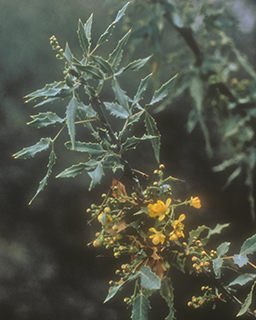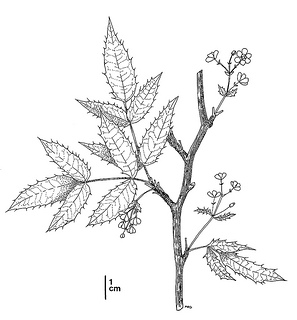(Berberis nevinii)
 Berberis nevinii in San Timoteo Canyon. CDFW photo by Susan Cochrane.
Berberis nevinii in San Timoteo Canyon. CDFW photo by Susan Cochrane.
 Berberis nevinii. CDFW illustration by Mary Ann Showers. (Click to enlarge)
Berberis nevinii. CDFW illustration by Mary Ann Showers. (Click to enlarge)
Nevin’s barberry is a California endangered plant species, which means that killing or possession of plants collected from the wild is prohibited by the California Endangered Species Act (CESA). Nevin’s barberry is also listed as endangered under the federal Endangered Species Act. Nevin’s barberry is an evergreen shrub, historically found at scattered locations in Los Angeles, San Bernardino, Riverside, and possibly San Diego Counties. The species is widely available in the nursery trade, and cultivated Nevin’s barberry plants have been introduced outside of the species’ native range. Nevin’s barberry is found in a variety of different topographical conditions ranging from nearly flat sandy washes, terraces, and canyon floors to ridges and mountain summits. Nevin’s barberry is also associated with mesic habitats and plant communities such as alluvial scrub, chamise chaparral, coastal sage scrub, oak woodland, and riparian scrub or woodland. Data also suggests that Nevin’s barberry may require long periods between fires for successful population growth. At the time of this webpage posting, the California Natural Diversity Database reports 21 natural occurrences of Nevin’s barberry presumed to still exist, and a majority of these occurrences consist of less than five individual plants.
Many of the remaining natural Nevin’s barberry occurrences are located on private land and could therefore be subject to impacts from development. Development could affect site topography, soil composition, and vegetation communities, introduce invasive species, increase erosion potential, change hydrological conditions, and increase the frequency of fire on the landscape. Recreational activities such as off-road vehicle use and fire management practices could also negatively affect Nevin’s barberry. In additional to these factors, the small population sizes and low reproductive output of Nevin’s barberry contribute to the risk of populations becoming extinct from unpredictable events.
To help prevent the extinction of Nevin’s barberry in the wild, occupied Nevin’s barberry habitat should be permanently protected and managed in cooperation with local authorities. The life history and low reproductive output of Nevin’s barberry should be investigated, with the goal of determining the best management practices for remaining populations. Status surveys should be conducted at known populations and potentially suitable habitat should be surveyed for undiscovered populations. The genetic origins of cultivated plants that are successfully reproducing should also be investigated.
CDFW may issue permits for Nevin’s barberry pursuant to CESA, and you can learn more about the California laws protecting Nevin’s barberry and other California native plants. Populations of Nevin’s barberry occur in CDFW’s South Coast Region and Inland Deserts Region. More information is also available from the U.S. Fish and Wildlife Service Species Profile for Nevin’s barberry.
Updated 9/23/2013